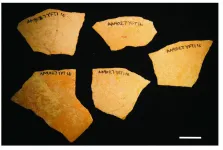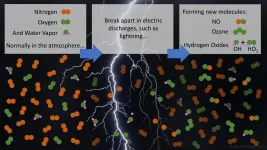(Press-News.org) The field of soft robotics has exploded in the past decade, as ever more researchers seek to make real the potential of these pliant, flexible automata in a variety of realms, including search and rescue, exploration and medicine.
For all the excitement surrounding these new machines, however, UC Santa Barbara mechanical engineering professor Elliot Hawkes wants to ensure that soft robotics research is more than just a flash in the pan. "Some new, rapidly growing fields never take root, while others become thriving disciplines," Hawkes said.
To help guarantee the longevity of soft robotics research, Hawkes, whose own robots have garnered interest for their bioinspired and novel locomotion and for the new possibilities they present, offers an approach that moves the field forward. His viewpoint, written with colleagues Carmel Majidi from Carnegie Mellon University and Michael T. Tolley of UC San Diego, is published in the journal Science Robotics.
"We were looking at publication data for soft robotics and noticed a phase of explosive growth over the last decade," Hawkes said. "We became curious about trends like this in new fields, and how new fields take root."
The first decade of widespread soft robotics research, according to the group, "was characterized by defining, inspiring and exploring," as roboticists took to heart what it meant to create a soft robot, from materials systems to novel ways of navigating through and interacting with the environment.
However, the researchers argue, "for soft robotics to become a thriving, impactful field in the next decade, every study must make a meaningful contribution." According to Hawkes, the long-term duration of a rapidly growing field is often a matter of whether the initial exploratory research matures.
With that in mind, the group presents a three-tiered categorization system to apply to future soft robotics work.
"The three-tier system categorizes studies within the field, not the field as a whole," Hawkes explained. "For example, there will be articles coming out this year that will be Level 0, Level 1 and Level 2. The goal is to push as many Level 0 studies toward Level 1 and Level 2."
From Baseline to Broad Contribution
"Soft for soft's sake" could be used to characterize Level 0 in the categorization system, as researchers have, for the past decade, rapidly and broadly explored new materials and mechanisms that could fall under the notion of "soft robot." While these studies were necessary to define the field, according to the authors, maintaining research at this level puts soft robotics at the risk of stagnation.
With the benefits of a solid foundation, present and future roboticists are now encouraged to identify areas for performance improvement and solutions to gaps in the knowledge of soft robotics -- the hallmark of Level 1. These studies will push the field forward, the researchers said, as novel results could elevate technological performance of soft systems.
However, they say, "whenever possible, we should strive to push beyond work that only contributes to our field." Studies in the Level 2 category go beyond soft robotics to become applications in the broader field of engineering. Here, softness is more than an artificial constraint, according to the paper; rather, it "advances state-of-the art technology and understanding across disciplines" and may even displace long-used conventional technologies.
One way to move beyond Level 0 lies in the training of the next generation of roboticists, the researchers said. Consolidating the best available knowledge contributed by previous work will prime those just entering the field to "ask the right questions" as they pursue their research.
"We hope that the categorization we offer will serve the field as a tool to help improve contribution, ideally increasing the impact of soft robotics in the coming decade," Hawkes said.
INFORMATION:
New York, NY--Research-practice partnerships (RPPs), long-term collaborations between researchers, policy makers and practitioners, represent an especially promising strategy for making sure that all children benefit from early childhood education, according to END ...
People living with a child who attends school in-person have an increased risk of reporting evidence of COVID-19, but teacher masking, symptom screening, and other mitigation measures in schools may be able to minimize that excess risk, suggests a study led by researchers at the Johns Hopkins Bloomberg School of Public Health.
For their study, the researchers analyzed nearly 600,000 responses from an ongoing Facebook-based COVID-19 symptom survey in the United States over two periods between November 2020 and February 2021 before vaccines were widely available in the U.S. The researchers found that those living with a child engaged in full-time, ...
April 29, 2021 -An increasing number of digital mental health interventions are designed for adolescents and young people with a range of mental health issues, but the evidence on their effectiveness is mixed, according to research by Columbia University Mailman School of Public Health and Spark Street Advisors.
Computerized cognitive behavioral therapy was found effective for anxiety and depression in adolescents and young people holding promise for increasing access to mental health treatment for these conditions. However, the effectiveness of other digital interventions, including therapeutic video games, mobile apps, or social networking sites, and addressing a range of other mental health outcomes remain ...
Archeologists have learned a lot about our ancestors by rummaging through their garbage piles, which contain evidence of their diet and population levels as the local flora and fauna changed over time.
One common kitchen scrap in Africa -- shells of ostrich eggs -- is now helping unscramble the mystery of when these changes took place, providing a timeline for some of the earliest Homo sapiens who settled down to utilize marine food resources along the South African coast more than 100,000 years ago.
Geochronologists at the University of California, Berkeley, and the Berkeley ...
The European house mouse has invaded nearly every corner of the Americas since it was introduced by colonizers a few hundred years ago, and now lives practically everywhere humans store their food.
Yet in that relatively short time span -- 400 to 600 mouse generations -- populations on the East and West Coasts have changed their body size and nest building behavior in nearly identical ways to adapt to similar environmental conditions, according to a new study by biologists at the University of California, Berkeley.
To make these adaptations -- at least in the case of body size -- mice in the Western United States ...
Research has shed new light on the impact of humans on Earth's biodiversity. The findings suggest that the rate of change in an ecosystem's plant-life increases significantly during the years following human settlement, with the most dramatic changes occurring in locations settled in the last 1500 years.
An international research team studied fossilised pollen dating back 5000 years, extracted from sediments on 27 islands. By analysing the fossils they were able to build up an understanding of the composition of each island's vegetation and how it changed from the oldest to the most recent pollen samples.
The study was led by Dr Sandra Nogué, Lecturer in Palaeoenvironmental ...
Researchers at Karolinska Institutet in Sweden have discovered a mechanism through which meningitis-causing bacteria can evade our immune system. In laboratory tests, they found that Streptococcus pneumoniae and Haemophilus influenzae respond to increasing temperatures by producing safeguards that keep them from getting killed. This may prime their defenses against our immune system and increase their chances of survival, the researchers say. The findings are published in the journal PLoS Pathogens.
"This discovery helps to increase our understanding of the mechanisms these bacteria use to evade our normal immune defenses," ...
Scientists have been able to track how a multi-drug resistant organism is able to evolve and spread widely among cystic fibrosis patients - showing that it can evolve rapidly within an individual during chronic infection. The researchers say their findings highlight the need to treat patients with Mycobacterium abscessus infection immediately, counter to current medical practice.
Around one in 2,500 children in the UK is born with cystic fibrosis, a hereditary condition that causes the lungs to become clogged up with thick, sticky mucus. The condition tends to decrease life expectancy among patients.
In recent years, M. abscessus, a species of multi-drug resistant bacteria, has emerged as a significant global threat to individuals with cystic fibrosis and other lung diseases. ...
Considerable gap in evidence around whether portable air filters reduce the incidence of COVID-19 and other respiratory infections
There is an important absence of evidence regarding the effectiveness of a potentially cost-efficient intervention to prevent indoor transmission of respiratory infections, including COVID-19, warns a study by researchers at the University of Bristol.
Respiratory infections such as coughs, colds, and influenza, are common in all age groups, and can be either viral or bacterial. Bacteria and viruses can become airborne via talking, coughing or sneezing. The current global coronavirus (COVID-19) pandemic is also spread primarily by airborne droplets, and to date has led to over three million deaths ...
Lightning bolts break apart nitrogen and oxygen molecules in the atmosphere and create reactive chemicals that affect greenhouse gases. Now, a team of atmospheric chemists and lightning scientists have found that lightning bolts and, surprisingly, subvisible discharges that cannot be seen by cameras or the naked eye produce extreme amounts of the hydroxyl radical -- OH -- and hydroperoxyl radical -- HO2.
The hydroxyl radical is important in the atmosphere because it initiates chemical reactions and breaks down molecules like the greenhouse gas methane. OH is the main driver of many compositional changes in the atmosphere.
"Initially, we looked at these huge OH and HO2 signals found in the clouds and asked, what is wrong with our instrument?" said William ...




